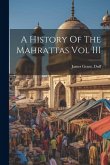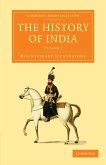James Grant Duff
A History of the Mahrattas - Volume 1
James Grant Duff
A History of the Mahrattas - Volume 1
- Broschiertes Buch
- Merkliste
- Auf die Merkliste
- Bewerten Bewerten
- Teilen
- Produkt teilen
- Produkterinnerung
- Produkterinnerung
Written by Scots historian James Grant Duff, this 1826 publication describes the history of the Marathi people in India.
Andere Kunden interessierten sich auch für
![A History of the Mahrattas - Volume 2 A History of the Mahrattas - Volume 2]() James Grant DuffA History of the Mahrattas - Volume 256,99 €
James Grant DuffA History of the Mahrattas - Volume 256,99 €![A History of the Mahrattas - Volume 3 A History of the Mahrattas - Volume 3]() James Grant DuffA History of the Mahrattas - Volume 361,99 €
James Grant DuffA History of the Mahrattas - Volume 361,99 €![A History Of The Mahrattas Vol III A History Of The Mahrattas Vol III]() James Grant DuffA History Of The Mahrattas Vol III33,99 €
James Grant DuffA History Of The Mahrattas Vol III33,99 €![The History of India, as Told by Its Own Historians - Volume 3 The History of India, as Told by Its Own Historians - Volume 3]() Henry Miers ElliotThe History of India, as Told by Its Own Historians - Volume 364,99 €
Henry Miers ElliotThe History of India, as Told by Its Own Historians - Volume 364,99 €![The History of India - Volume 1 The History of India - Volume 1]() Mountstuart ElphinstoneThe History of India - Volume 164,99 €
Mountstuart ElphinstoneThe History of India - Volume 164,99 €![The History of India, as Told by Its Own Historians - Volume 2 The History of India, as Told by Its Own Historians - Volume 2]() Henry Miers ElliotThe History of India, as Told by Its Own Historians - Volume 262,99 €
Henry Miers ElliotThe History of India, as Told by Its Own Historians - Volume 262,99 €![The History of India, as Told by Its Own Historians - Volume 7 The History of India, as Told by Its Own Historians - Volume 7]() Henry Miers ElliotThe History of India, as Told by Its Own Historians - Volume 761,99 €
Henry Miers ElliotThe History of India, as Told by Its Own Historians - Volume 761,99 €-
-
-
Written by Scots historian James Grant Duff, this 1826 publication describes the history of the Marathi people in India.
Hinweis: Dieser Artikel kann nur an eine deutsche Lieferadresse ausgeliefert werden.
Hinweis: Dieser Artikel kann nur an eine deutsche Lieferadresse ausgeliefert werden.
Produktdetails
- Produktdetails
- Verlag: Cambridge University Press
- Seitenzahl: 614
- Erscheinungstermin: 21. Januar 2011
- Englisch
- Abmessung: 216mm x 140mm x 36mm
- Gewicht: 854g
- ISBN-13: 9781108072991
- ISBN-10: 1108072992
- Artikelnr.: 33166637
- Herstellerkennzeichnung
- Libri GmbH
- Europaallee 1
- 36244 Bad Hersfeld
- gpsr@libri.de
- Verlag: Cambridge University Press
- Seitenzahl: 614
- Erscheinungstermin: 21. Januar 2011
- Englisch
- Abmessung: 216mm x 140mm x 36mm
- Gewicht: 854g
- ISBN-13: 9781108072991
- ISBN-10: 1108072992
- Artikelnr.: 33166637
- Herstellerkennzeichnung
- Libri GmbH
- Europaallee 1
- 36244 Bad Hersfeld
- gpsr@libri.de
Preface; Preliminary observations. Respecting the geography
chief features
climate
people
religion
learning
early history
and institutions of the Mahratta country; 1. From AD 1000
to AD 1478. Conquest of the Deccan by the Mahomedans; 2. From AD 1478
to AD 1637. Five independent states arise from the dismembered monarchy
which afterwards form the three kingdoms of Ahmednugur
Beejapoor
and Golcandah; 3. From AD 1637
to AD 1648. Shahjee's progress after entering the service of Beejapoor; 4. From AD 1648
to AD 1657. Local authorities under the Beejapoor government
in the immediate neighbourhood of Sivajee; 5. From AD 1657
to AD 1662. Sivajee enters into a correspondence with Aurungzebe; 6. From 1662
to AD 1667. Savajee attacks the Moghul possessions; 7. From AD 1667
to AD 1669. Sultan Mauzum and Jeswunt Sing; 8. From AD 1670
to AD 1676. The tranquility of the Deccan is interrupted; 9. From AD 1676
to AD 1680. State of politics in the Deccan when Sivajee undertakes his expedition into the Carnatic; 10. From AD 1680
to AD 1689. Cruelties exercised by Sumbhajee on assuming power; 11. From AD 1689
to AD 1707. Raja Ram; 12. From AD 1707
to AD 1720. Shao; 14. From AD 1720
to AD 1726. Nizam Ool Moolk
throwing off his dependance on the Syuds
determines on possessing himself of the resources of the Deccan; 15. From AD 1727
to AD 1734. Plans of Nizam Ool Moolk for consolidating his own power
and of creating dissensions among the Mahrattas; 15. From AD 1734
to AD 1739. Mahratta affairs; 16. From AD 1739
to AD 1740. The government of Malwa not formally conceded to Bajee Rao as promised by Mizam Ool Moolk.
chief features
climate
people
religion
learning
early history
and institutions of the Mahratta country; 1. From AD 1000
to AD 1478. Conquest of the Deccan by the Mahomedans; 2. From AD 1478
to AD 1637. Five independent states arise from the dismembered monarchy
which afterwards form the three kingdoms of Ahmednugur
Beejapoor
and Golcandah; 3. From AD 1637
to AD 1648. Shahjee's progress after entering the service of Beejapoor; 4. From AD 1648
to AD 1657. Local authorities under the Beejapoor government
in the immediate neighbourhood of Sivajee; 5. From AD 1657
to AD 1662. Sivajee enters into a correspondence with Aurungzebe; 6. From 1662
to AD 1667. Savajee attacks the Moghul possessions; 7. From AD 1667
to AD 1669. Sultan Mauzum and Jeswunt Sing; 8. From AD 1670
to AD 1676. The tranquility of the Deccan is interrupted; 9. From AD 1676
to AD 1680. State of politics in the Deccan when Sivajee undertakes his expedition into the Carnatic; 10. From AD 1680
to AD 1689. Cruelties exercised by Sumbhajee on assuming power; 11. From AD 1689
to AD 1707. Raja Ram; 12. From AD 1707
to AD 1720. Shao; 14. From AD 1720
to AD 1726. Nizam Ool Moolk
throwing off his dependance on the Syuds
determines on possessing himself of the resources of the Deccan; 15. From AD 1727
to AD 1734. Plans of Nizam Ool Moolk for consolidating his own power
and of creating dissensions among the Mahrattas; 15. From AD 1734
to AD 1739. Mahratta affairs; 16. From AD 1739
to AD 1740. The government of Malwa not formally conceded to Bajee Rao as promised by Mizam Ool Moolk.
Preface; Preliminary observations. Respecting the geography
chief features
climate
people
religion
learning
early history
and institutions of the Mahratta country; 1. From AD 1000
to AD 1478. Conquest of the Deccan by the Mahomedans; 2. From AD 1478
to AD 1637. Five independent states arise from the dismembered monarchy
which afterwards form the three kingdoms of Ahmednugur
Beejapoor
and Golcandah; 3. From AD 1637
to AD 1648. Shahjee's progress after entering the service of Beejapoor; 4. From AD 1648
to AD 1657. Local authorities under the Beejapoor government
in the immediate neighbourhood of Sivajee; 5. From AD 1657
to AD 1662. Sivajee enters into a correspondence with Aurungzebe; 6. From 1662
to AD 1667. Savajee attacks the Moghul possessions; 7. From AD 1667
to AD 1669. Sultan Mauzum and Jeswunt Sing; 8. From AD 1670
to AD 1676. The tranquility of the Deccan is interrupted; 9. From AD 1676
to AD 1680. State of politics in the Deccan when Sivajee undertakes his expedition into the Carnatic; 10. From AD 1680
to AD 1689. Cruelties exercised by Sumbhajee on assuming power; 11. From AD 1689
to AD 1707. Raja Ram; 12. From AD 1707
to AD 1720. Shao; 14. From AD 1720
to AD 1726. Nizam Ool Moolk
throwing off his dependance on the Syuds
determines on possessing himself of the resources of the Deccan; 15. From AD 1727
to AD 1734. Plans of Nizam Ool Moolk for consolidating his own power
and of creating dissensions among the Mahrattas; 15. From AD 1734
to AD 1739. Mahratta affairs; 16. From AD 1739
to AD 1740. The government of Malwa not formally conceded to Bajee Rao as promised by Mizam Ool Moolk.
chief features
climate
people
religion
learning
early history
and institutions of the Mahratta country; 1. From AD 1000
to AD 1478. Conquest of the Deccan by the Mahomedans; 2. From AD 1478
to AD 1637. Five independent states arise from the dismembered monarchy
which afterwards form the three kingdoms of Ahmednugur
Beejapoor
and Golcandah; 3. From AD 1637
to AD 1648. Shahjee's progress after entering the service of Beejapoor; 4. From AD 1648
to AD 1657. Local authorities under the Beejapoor government
in the immediate neighbourhood of Sivajee; 5. From AD 1657
to AD 1662. Sivajee enters into a correspondence with Aurungzebe; 6. From 1662
to AD 1667. Savajee attacks the Moghul possessions; 7. From AD 1667
to AD 1669. Sultan Mauzum and Jeswunt Sing; 8. From AD 1670
to AD 1676. The tranquility of the Deccan is interrupted; 9. From AD 1676
to AD 1680. State of politics in the Deccan when Sivajee undertakes his expedition into the Carnatic; 10. From AD 1680
to AD 1689. Cruelties exercised by Sumbhajee on assuming power; 11. From AD 1689
to AD 1707. Raja Ram; 12. From AD 1707
to AD 1720. Shao; 14. From AD 1720
to AD 1726. Nizam Ool Moolk
throwing off his dependance on the Syuds
determines on possessing himself of the resources of the Deccan; 15. From AD 1727
to AD 1734. Plans of Nizam Ool Moolk for consolidating his own power
and of creating dissensions among the Mahrattas; 15. From AD 1734
to AD 1739. Mahratta affairs; 16. From AD 1739
to AD 1740. The government of Malwa not formally conceded to Bajee Rao as promised by Mizam Ool Moolk.








